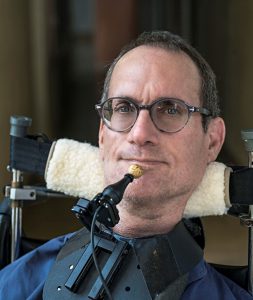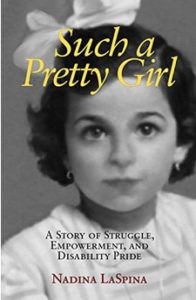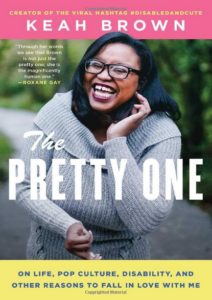A Tale of Two Pretties
by Ben Mattlin
In late summer, two books by disabled women were published with strikingly similar titles: The Pretty One: On Life, Pop Culture, Disability, and Other Reasons to Fall in Love with Me by Keah Brown (Atria Books) and Such a Pretty Girl: A Story of Struggle, Empowerment, and Disability Pride by Nadina LaSpina (New Village Press).
September 23, 2019
Whether you call this a coincidence or a sign of the times, these books by first-time authors certainly seem to signify a growing appetite among publishers and readers for disability life stories.
“The Pretty One”– #DisabledandCute
The Pretty One is by Keah Brown, a 20-something African-American woman with cerebral palsy. A journalist who has interviewed several celebrities, she’s perhaps best known for launching the viral hashtag #DisabledandCute.
She has her finger on the pulse of her generation.
The book is a collection of smart, lighthearted yet profound, essays about her life thus far, and her perspective on our culture. Her tone is breezy and companionable, but don’t be fooled. The points she makes are eye-opening.
For example: “Black people with disabilities are all but invisible [in popular culture].” She dreams of a future with better representation of what’s come to be known as, Intersectionality. She’d like to move to Hollywood, write for TV and “create a nuanced disabled woman who experiences the full spectrum of emotion, but ultimately loves herself and doesn’t make disability her every waking thought.”
Brown writes about how she used to try to pass as nondisabled with her able-bodied friends. She would go on long walks with them and make excuses when she got winded. Then, not long ago, she had a transformation. She not only learned to understand her cerebral palsy; she learned not to hate it—and therefore not hate herself.
You may shed a few tears as you read this book. Not because it’s sad, but because it’s authentic and personal. There are no pretenses. She’s done with pretending.
But you may also laugh out loud. I did. One of my favorite pieces is the essay about her love affair with chairs, titled “Can we sit for a sec?” “My longest relationship has been with chairs,” she quips. Her beloved home sofa, which she names Vivian, has been “kind to me,” she says, adding, “Trust me, she looks like a Vivian.” Then she admits to trysting with a movie theater seat, dubbed Paul. “Paul and I don’t get to see each other often,” she laments, “because movies are expensive, and he can never get away from work.”
I’ll admit I’m too old to get many of the pop culture references sprinkled throughout. That’s okay. The book isn’t really aimed at people like me—white, male, mid-50s. Which is sort of Brown’s point. Disabled women of color have a voice that should be heard, too.
“Such a Pretty Girl—What a Shame!”
Nadina LaSpina, on the other hand, is in her early 70’s, and the world she writes about is closer to the one I know. In fact, though I’ve never met her, her straightforward memoir describes a number of places, people, and events I know personally.
Still, I learned a great deal from her perspective. Her story begins in a small town in southern Italy where LaSpina was born and contracted polio at a young age. “Such a pretty girl,” the locals declared, soon adding, “What a shame!”
In Italian, LaSpina tells us, the word for “shame” is akin to the word for “sin”. But what sin had this baby girl committed? And why did her mother cry so much over her? She wants to make her mother happy. So when her father decides to take the family to America, where he’s convinced doctors can cure her, she scarcely objects.
In the hospital in New York, the adolescent LaSpina learns to use a wheelchair and begins to learn English. She bonds with the other teenagers on the ward. Soon, however, life turns sour. LaSpina describes with dispassionate honesty the sexual abuse she endured while hospitalized. She’s routinely forced to undress in front of groups of nameless doctors and nurses. She agrees to countless surgeries on her legs. So when some nighttime staffers touch her inappropriately, she doesn’t complain. She feels no agency over her own body.
“A scalpel or a penis–What was the difference?” she writes. “I’d gotten used to strangers touching me, handling me, manipulating me, doctors cutting me up, over and over again, inflicting pain. Pain or pleasure–What was the difference? After all, what claim could I have on this defective, damaged, disabled body?”
It’s powerful prose. The mood lightens when LaSpina learns to drive a car with hand controls, goes to college, and ultimately gets a job teaching Italian. In 1970, at 22, she reads about Judy Heumann’s lawsuit against the New York Board of Education for discrimination. Heumann, also a polio survivor, wanted to teach in public schools but was barred because of her disability. The Board backed down and she got the job.
LaSpina was inspired to become an activist.
She acknowledges feeling conflicted at first: joining the movement made her feel accepted and whole, but part of her still wanted to fit in with “normal” people.
Gradually LaSpina got swept up in the empowerment of activism. She delighted in being arrested at a protest demonstration in Washington, DC, and rejoiced when the Americans With Disabilities Act became law. Shortly after, she helped organize the first Disability Pride march.
The final sections of this fast-reading book describe her long romance with a fellow activist named Danny. They live together and eventually marry while continuing to attend demonstrations, despite health problems that come with age.
LaSpina’s prose has the clear, instructive quality of an inveterate teacher.
By the end, you will learn a lot about the movement. But you will also feel as if you’ve made a new friend.
Postscript: One More Book…
Another new book by and about people with disabilities is also on the market: About Us: Essays from the Disability Series of the New York Times, edited by Peter Catapano and Rosemarie Garland-Thomson, from Liveright Publishing. It comprises more than 60 pieces previously published in the Times. Neither of the “pretty” authors are included, but your humble reviewer is.
 Our special contributor Ben Mattlin, was born with spinal muscular atrophy (SMA), a congenital muscle weakness that causes paralysis and related health issues. A highly regarded writer, Ben’s work has appeared in “The New York Times,” “The Washington Post” and “USA Today.” He lives in Los Angeles with his wife and children.
Our special contributor Ben Mattlin, was born with spinal muscular atrophy (SMA), a congenital muscle weakness that causes paralysis and related health issues. A highly regarded writer, Ben’s work has appeared in “The New York Times,” “The Washington Post” and “USA Today.” He lives in Los Angeles with his wife and children.


Leave a Reply